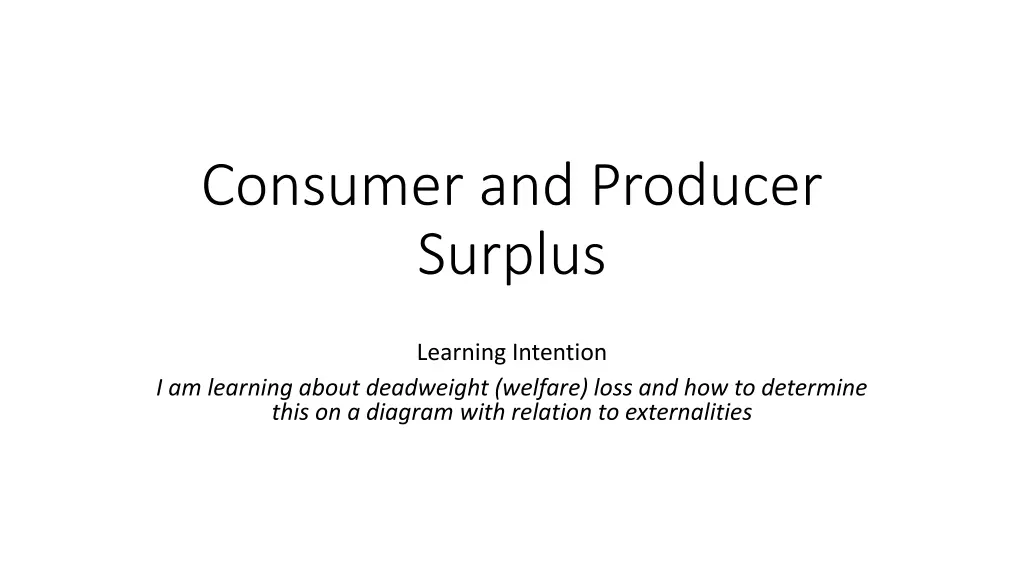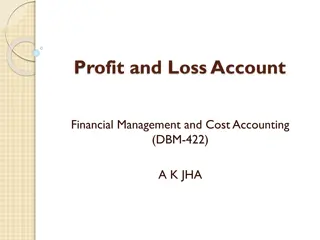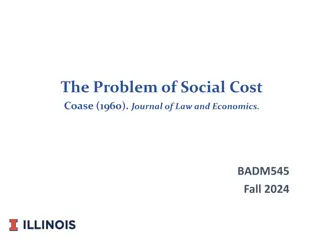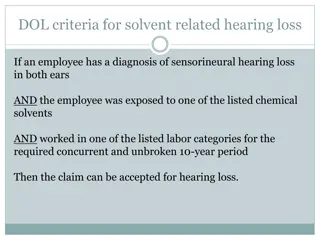
Understanding Consumer and Producer Surplus, Deadweight Loss, and Externalities in Economics
Explore the concepts of consumer and producer surplus, deadweight loss, and externalities in economics with diagrams illustrating their impact on market efficiency and societal welfare. Learn how to identify these factors and evaluate their effects on resource allocation.
Download Presentation

Please find below an Image/Link to download the presentation.
The content on the website is provided AS IS for your information and personal use only. It may not be sold, licensed, or shared on other websites without obtaining consent from the author. If you encounter any issues during the download, it is possible that the publisher has removed the file from their server.
You are allowed to download the files provided on this website for personal or commercial use, subject to the condition that they are used lawfully. All files are the property of their respective owners.
The content on the website is provided AS IS for your information and personal use only. It may not be sold, licensed, or shared on other websites without obtaining consent from the author.
E N D
Presentation Transcript
Consumer and Producer Surplus Learning Intention I am learning about deadweight (welfare) loss and how to determine this on a diagram with relation to externalities
Consumer surplus The highest price consumers are willing to pay for a good, minus what they actually paid (the equilibrium price) This is all the area above the equilibrium price and below the demand curve
Producer surplus The price received by firms selling their good, minus the lowest price they are willing to accept to produce This is the space below the equilibrium price and above the supply curve
Deadweight loss A deadweight loss is a cost to society created by market inefficiency, which occurs when supply and demand are out of equilibrium. Deadweight loss can be applied to any deficiency caused by an inefficient allocation of resources.
Externalities Can be positive or negative Positive Production where the production of a product increases the wellbeing of others, but the firm is not compensated for it E.g. beehives help pollinate other trees Consumption where an individual s consumption increases the wellbeing of others, but the individual is not compensated for it E.g. vaccination, education, a nice garden Negative Production Where a firms decision to produce decreases the wellbeing of others and those others are not compensated E.g. Pollution, deforestation, dumping of waste Consumption where individual s consumption negatively affects others, but the individual does not compensate those others E.g. smoking, obesity, car pollution
Showing Externalities on a diagram Marginal Private Cost the cost directly incurred by the producer This is equal to supply in a free market Marginal Private Benefit The benefit derived directly by the consumer This is equal to demand in a free market Marginal Social Cost the added cost to society in addition to what the producer has E.g. a tax put on top of a product for producers Marginal Social Benefit the added benefit to society in addition to what the consumer gets
Showing externalities on a diagram Where MPC and MPB intersect is the market equilibrium MPC = Supply Where resources are not used for the maximum benefit of both consumers and producers, the social optimal (or allocative efficiency) is not achieved Social costs or benefits are in additionto these. MPB = Demand
Showing externalities on a diagram MSC = the additional cost per unit to society that society is not compensated for Where MPC and MPB intersect is the market equilibrium MPC = Supply Popt Pe Where resources are not used for the maximum benefit of both consumers and producers, the social optimal (or allocative efficiency) is not achieved Social costs or benefits are in additionto these. MPB = Demand Qopt Qe
Displaying Positive Production externalities MPC = Supply MSC MPB = Demand E.g. Beehives, R&D companies
Positive Production Externalities MPC = Supply MSC The market is not operating efficiently, so there is a deadweight loss in the shaded area. There is an under-allocation of resources Pe Popt MPB = Demand Qe Qopt
Displaying Negative Production Externalities MPC = Supply MPB = Demand E.g. Pollution, dumping waste, deforestation
Negative Production Externalities MSC The additional cost per unit to society. The market is not operating efficiently, so there is a deadweight loss in the shaded area. There is an under-allocation of resources MPC = Supply Popt Pe MPB = Demand Qopt Qe
Displaying Positive Consumption Externalities MPC = Supply MPB = Demand E.g. Vaccination, education, garden
Positive Consumption Externalities MPC = Supply Popt Pe MSB = The added benefit that society gets from the externality. There is a deadweight loss because society could allocate more resources to this, but is not. MPB = Demand Qe Qopt
Displaying Negative Consumption Externalities MPC = Supply MPB = Demand E.g. Smoking, obesity, car pollution
Negative Consumption Externalities MPC = Supply Pe Popt MPB = Demand Qopt Qe MSB There is an overallocation of resources at Qe
Watch the following videos on determining https://www.youtube.com/watch?v=FILWIIid9C4 https://www.youtube.com/watch?v=4v-rt0w12L8 https://www.youtube.com/watch?v=nBw6KvU51BE Take Cornell Notes as you go on the learning intention






















